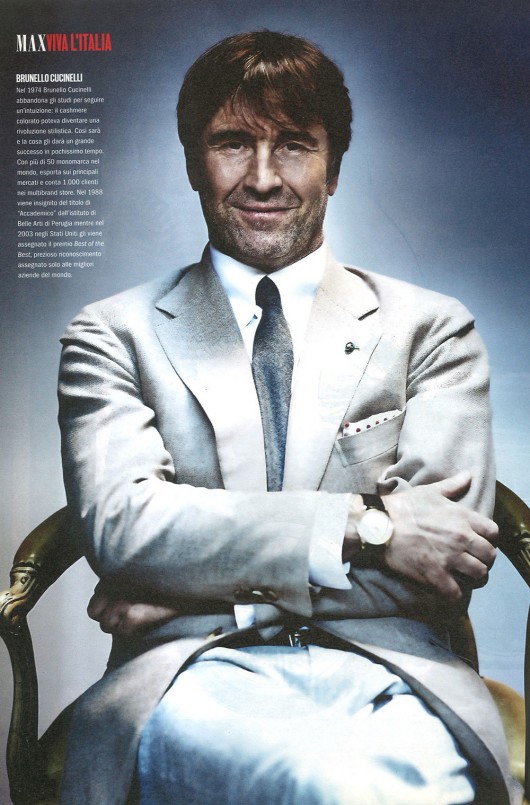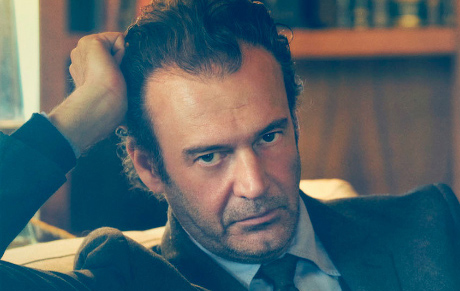ETICA E BELLEZZA
Brunello Cucinelli in una foto di Giovanni Gastel, Max Aprile 2011
Quando si parla di moda etica, vengono spesso in mente prodotti dai colori slavati e tagliati alla buona ma moralmente ineccepibili, eseguiti da aziende finanziate dal microcredito femminile in qualche parte avvilita del mondo toccata dalla bontà di uno o più marchi. E salvata.
Questo, però è un approccio di apprezzabile buonismo che non risolve alla base la domanda per eccellenza. E cioè: l’oggetto vale effettivamente la cifra che è richiesta in cambio? La materia prima, il design, il costo del lavoro, la proprietà intellettuale sono effettivamente ripagate, assieme al giusto profitto dell’imprenditore o ci stanno truffando se non peggio? A queste domande deve rispondere un’etica della moda che voglia essere autentica e capace di dirimere i problemi che l’enorme espansione del fashion ha posto, delocalizzando le produzioni, predando l’originalità intellettuale, portando i prodotti a prezzi bassissimi. Peccato che a pagarli sia troppo spesso un lavorante bambino. O il giovane designer che si vede rubati lavoro e idee in cambio dello stipendio. Il vero buon prodotto ha tutto da guadagnare se segue le linee etiche. E se è in grado di giustificare l’esborso che richiede. Ne deriva che il meglio dei prodotti italiani a sua volta ne tragga vantaggio, specie nell’ottica di una giustificazione della spesa. Nella moda maschile la qualità della materia prima è percepibile in modo più immediato rispetto a quella femminile. E le trecce di un golf fatte a mano in cachemire di prima scelta, le calature delle maniche, le rifiniture del capo rendono più o meno etico il “money for value” dell’acquirente. Cucinelli si fa un vanto della sua maglieria hand made nelle campagne italiane, della qualità complessiva del suo prodotto. Arriva persino ad una redistribuzione dei guadagni con la sua manovalanza. E se il tempo dirà dove arriverà questo seguace di Olivetti, intanto un risultato lo ha raggiunto: fare vedere che etica e bellezza spesso coincidono. Luisa Ciuni
The subject “ethical fashion” often recalls us garments in faded colours and off-hand cut but morally irreproachable, made by companies financed by female microcredit in a discouraged part of the world touched by the goodness of one or more brands. And saved. But this is an approach of remarkable do-goodery that doesn’t solve the “it” question. That is: is the garment as expensive as it’s worth? Are the raw materials, the design, the cost of labour, the intellectual property actually paid back, or is it a fraud? These questions has to be solved by a fashion ethic that wants to be authentic and able to settle the problems due to the huge expansion of fashion, with manufacturing outsourcing, imitations, low prices. That too often are paid by a child worker. Or by the young designer robbed of his work and ideas in return for the salary. The real good product takes only advantages if it follows the ethical line. And if it can justify its price. From this comes that the best of italian products takes advantage from this, especially from the perspective of costs justification. In menswear the quality of raw materials is more perceivable than in womenswear. And the handmade braids of a cardigan made of very fine cashmere, the sleeves’ drop-stitch, the garment’s finishing make the customer’s “money for value” more or less ethical. Cucinelli takes pride of his knitwear, hand-made in the italian country, of the general quality of his products. He even redistributes the earnings with his labourers. And if time will tell which goals this Olivetti’s disciple will achieve, in the meantime he has reached a result: showing that ethics and beauty often coincide. Luisa Ciuni
NESSUN COMMENTO






